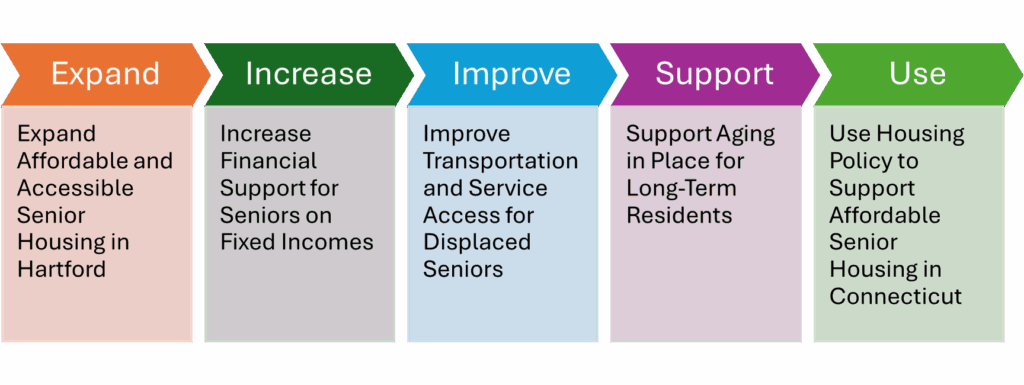Policy Suggestions for Affordable Senior Housing in Connecticut

1. Expand Affordable and Accessible Senior Housing in Hartford
- Findings: 41.9% of seniors say housing has become less affordable with age, and 39% have had to leave Hartford due to lack of options.
Recommendations:
- Transform High-Priority Vacant Lots into Senior Housing:
- Target high-priority lots in neighborhoods like Barry Square, Frog Hollow, and the South End that are:
- Near bus stops, healthcare centers, and grocery stores
- Already city-owned or easily acquired
- Large enough to support multi-unit developments
- Pilot Mixed-Income Housing Project: Collaborate with Mutual Housing and city partners to develop one site that includes health-supportive features and communal spaces.
- Incentivize Developers: Offer tax abatements or create public-private partnerships to support the development of deeply affordable senior housing units with necessary accessibility features.
- Require Universal Design Standards: Ensure all new senior housing developments meet accessibility needs, including step-free entries, grab bars, and wide doorways.
- Target high-priority lots in neighborhoods like Barry Square, Frog Hollow, and the South End that are:
2. Increase Financial Support for Seniors on Fixed Incomes
- Findings: 48.4% of seniors find housing only somewhat affordable, and 32.3% experience financial strain.
Recommendations:
- Advocate for Expanded Rental Assistance: Push for rental assistance or housing vouchers targeted specifically at seniors to make housing more affordable.
- Increase Awareness of Assistance Programs: Raise awareness about and help seniors enroll in existing utility assistance and property tax relief programs.
- Home Repair Support: Offer grants or forgivable loans for low-income senior homeowners to address critical home repairs and prevent displacement.
3. Improve Transportation and Service Access for Displaced Seniors
- Findings: Many seniors who moved to nearby towns feel isolated and often return to Hartford for services and community.
Recommendations:
- Expand Senior Transportation Routes: Partner with regional transit providers to create reliable transportation options for seniors traveling between suburbs and Hartford’s health/social service hubs.
- Locate Housing Near Services: Ensure future senior housing developments are within walking distance of essential services like grocery stores, clinics, pharmacies, and bus stops.
- Mobile Health Services: Fund mobile health units or satellite community centers in areas where displaced seniors have relocated to maintain access to healthcare.
4. Support Aging in Place for Long-Term Residents
- Findings: 65% of seniors have lived in their homes for more than 10 years, but 60% say their housing no longer meets their needs.
Recommendations:
- Home Repair Support for Aging Residents: Identify neighborhoods, particularly South End and Frog Hollow, where home repair services are most needed.
- Provide ADA Upgrade Grants: Offer city grants or revolving loans to help seniors make necessary upgrades to their homes, including ramps, grab bars, and walk-in showers, to support aging in place.
5. Use Housing Policy to Support Affordable Senior Housing in Connecticut
To meet the growing need for affordable senior housing, Connecticut should improve how it uses federal housing tax credits (LIHTC) by updating its Qualified Allocation Plan (QAP).
Recommendations:
- Reserve Credits for Senior Housing: Set aside a portion of housing tax credits specifically for affordable senior housing developments to demonstrate the state’s commitment to aging residents.
- Reward Senior-Friendly Projects: Update the scoring system to give additional points to projects that:
- Include accessibility features
- Are near healthcare, public transit, and other essential services
- Offer health or supportive services for seniors
- Make Projects Financially Feasible: Allow a 30% “basis boost” for senior housing projects, particularly in under-resourced areas, to help make these developments financially viable.
- Strengthen Nonprofit Partnerships: Use the federally required 10% nonprofit set-aside more strategically to support nonprofit-led senior housing initiatives.
- Advocate for Seniors in QAP Updates: Engage in annual public hearings to advocate for senior-friendly priorities, highlighting challenges such as accessibility, proximity to care, and the need for community-building features in housing projects.